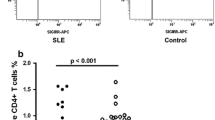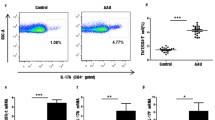Abstract
To investigate the variations of T-helper 17 (Th17) and regulatory T (Treg) cells in patients with lupus nephritis (LN), a total of 60 systemic lupus erythematosus patients and 28 healthy controls (HCs) were enrolled. The frequency of Th17 cells and Treg cells in peripheral blood mononuclear cells (PBMCs) was evaluated by flow cytometric analysis. The serum concentrations of interleukin-17 (IL-17) and transforming growth factor-beta 1 (TGF-β1) were measured by enzyme-linked immunosorbent assay (ELISA). The results demonstrated in LN patients a significant decrease in the frequency of CD4+CD25high and CD4+CD25+FoxP3+ T cells and a significant increase in the frequency of Th17 cells in peripheral blood, and the ratio of Th17 to Treg cell frequency was significantly increased along with increased SLEDAI scores. LN patients had a lower percentage and expression of FoxP3 in CD4+CD25high T cells than SLE patients without nephritis. The concentration of TGF-β1 was found decreased in SLE patients compared with that from healthy controls, though no significant difference was found between LN patients and SLE patients without nephritis. The expression of IL-17 levels in LN patients exhibited a significant increase compared with patients without nephritis and healthy controls. Based on our results, the significantly elevated Th17 cells are accompanied by FoxP3+ Treg cells decrease in lupus nephritis, suggesting that Th17/Treg functional imbalance may be involved in the pathogenesis of renal damage in SLE patients.





Similar content being viewed by others
References
Heinlen LD, McClain MT, Merrill J et al (2007) Clinical criteria for systemic lupus erythematosus precede diagnosis, and associated autoantibodies are present before clinical symptoms. Arthr Rheum 56:2344–2351
Mok CC, Ying KY, Ng WL et al (2006) Long-term outcome of diffuse proliferative lupus glomerulonephritis treated with cyclophosphamide. Am J Med 119:355.e25–355.e33
Korn T, Bettelli E, Oukka M, Kuchroo VK (2009) IL-17 and Th17 cells. Annu Rev Immunol 27:485–517
Nalbandian A, Crispin JC, Tsokos GC (2009) Interleukin-17 and systemic lupus erythematosus: current concepts. Clin Exp Immunol 157:209–215
Crispin JC, Oukka M, Bayliss G et al (2008) Expanded double negative T cells in patients with systemic lupus erythematosus produce IL-17 and infiltrate the kidneys. J Immunol 181:8761–8766
Bettelli E, Carrier Y, Gao W et al (2006) Reciprocal developmental pathways for the generation of pathogenic effector TH17 and regulatory T cells. Nature 441:235–238
Brenda A, Berenice HC, Diana P et al (2006) Regulatory T cells in patients with systemic lupus erythematosus. J Autoimmun 27:110–118
Hochberg MC (1997) Updating the American College of Rheumatology revised criteria for the classification of systemic lupus erythematosus. Arthr Rheum 40:1725
Bombardier C, Gladman DD, Urowitz MB, Caron D, Chang CH (1992) Derivation of the SLEDAI: a disease activity index for lupus patients. Arthr Rheum 35:630–640
Fontenot JD, Gavin MA, Rudensky AY (2003) Foxp3 programs the development and function of CD4+CD25+ regulatory T cells. Nat Immunol 4:330–336
Ochs HD, Oukka M, Torgerson TR (2009) TH17 cells and regulatory T cells in primary immunodeficiency diseases. J Allergy Clin Immunol 123:977–983
Pan HF, Ye DQ, Li XP (2008) Type 17 T-helper cells might be a promising therapeutic target for systemic lupus erythematosus. Nat Clin Pract Rheumatol 4:352–353
Bettelli E, Carrier Y, Gao W et al (2006) Reciprocal developmental pathways for the generation of pathogenic effector TH17 and regulatory T cells. Nature 441:235–238
Afzali B, Lombardi G, Lechler RI, Lord GM (2007) The role of T helper 17 (Th17) and regulatory T cells (Treg) in human organ transplantation and autoimmune disease. Clin Exp Immunol 148:32–46
Baecher-Allan C, Brown JA, Freeman GJ, Hafler DA (2001) CD4+CD25high regulatory cells in human peripheral blood. J Immunol 167:1245–1253
Yagi H, Nomura T, Nakamura K et al (2004) Crucial role of FOXP3 in the development and function of human CD25+CD4+ regulatory T cells. Int Immunol 16:1643–1656
Gavin MA, Rasmussen JP, Fontenot JD et al (2007) Foxp3-dependent programme of regulatory T-cell differentiation. Nature 445:771–775
Wan YY, Flavell RA (2007) Regulatory T-cell functions are subverted and converted owing to attenuated Foxp3 expression. Nature 445:766–770
Mellor-Pita S, Citores MJ, Castejon R et al (2006) Decrease of regulatory T cells in patients with systemic lupus erythematosus. Ann Rheum Dis 65:553–554
Barath S, Aleksza M, Tarr T, Sipka S, Szegedi G, Kiss E (2007) Measurement of natural (CD4+CD25high) and inducible (CD4+IL-10+) regulatory T cells in patients with systemic lupus erythematosus. Lupus 16:489–496
Yan B, Ye S, Chen G, Kuang M, Shen N, Chen S (2008) Dysfunctional CD4+CD25+ regulatory T cells in untreated active systemic lupus erythematosus secondary to interferon-α-producing antigen-presenting cells. Arthr Rheum 58:801–812
Lee HY, Hong YK, Yun HJ, Kim YM, Kim JR, Yoo WH (2008) Altered frequency and migration capacity of CD4+CD25+ regulatory T cells in systemic lupus erythematosus. Rheumatology 47:789–794
Crispin JC, Martinez A, Alcocer-Varela J (2003) Quantification of regulatory T cells in patients with systemic lupus erythematosus. J Autoimmun 21:273–276
Zhang B, Zhang X, Tang FL, Zhu LP, Liu Y, Lipsky PE (2008) Clinical significance of increased CD4+CD25-FoxP3+T cells in patients with new-onset systemic lupus erythematosus. Ann Rheum Dis 67:1037–1040
Bonelli M, Savitskaya A, Dalwigk KV et al (2008) Quantitative and qualitative deficiencies of regulatory T cells in patients with systemic lupus erythematosus (SLE). Int Immunol 20:861–868
Vargas-Rojas MI, Crispín JC, Richaud-Patin Y, Alcocer-Varela J (2008) Quantitative and qualitative normal regulatory T cells are not capable of inducing suppression in SLE patients due to T-cell resistance. Lupus 17:289–294
Zhang B, Zhang X, Tang FL, Zhu L, Liu Y (2008) Reduction of forkhead box P3 levels in CD4+CD25 high T cells in patients with new onset systemic lupus erythematosus. Clin Exp Immunol 153:182–187
Abe J, Ueha S, Suzuki J et al (2008) Increased Foxp3+CD4+ Regulatory T Cells with Intact Suppressive Activity but Altered Cellular Localization in Murine Lupus. Am J Pathol 173:1682–1692
Zhou L, Lopes JE, Chong MM et al (2008) TGF-beta-induced Foxp3 inhibits T(H)17 cell differentiation by antagonizing RORgammat function. Nature 453:236–240
Langrish CL, Chen Y, Blumenschein WM et al (2005) IL-23 drives a pathogenic T cell population that induces autoimmune inflammation. J Exp Med 201:233–240
Nakae S, Nambu A, Sudo K, Iwakura Y (2003) Suppression of immune induction of collagen-induced arthritis in IL-17-deficient mice. J Immunol 171:6173–6177
Dong GF, Ye RG, Shi W et al (2003) IL-17 induces autoantibody overproduction and peripheral blood mononuclear cell overexpression of IL-6 in lupus nephritis patients. Chin Med J (Engl) 116:543–548
Kang HK, Liu M, Datta SK (2007) Low-dose peptide tolerance therapy of lupus generates plasmacytoid dendritic cells that cause expansion of autoantigen-specific regulatory T cells and contraction of inflammatory Th17 cells. J Immunol 178:7849–7858
Hsu HC, Yang P, Wang J et al (2008) Interleukin 17-producing T helper cells and interleukin 17 orchestrate autoreactive germinal center development in autoimmune BXD2 mice. Nat Immunol 9:166–175
Chen XQ, Yu YC, Deng HH et al (2010) Plasma IL-17A is increased in new-onset SLE patients and associated with disease activity. J Clin Immunol 30:221–225
Conflict of interest
None.
Author information
Authors and Affiliations
Corresponding author
Rights and permissions
About this article
Cite this article
Xing, Q., Wang, B., Su, H. et al. Elevated Th17 cells are accompanied by FoxP3+ Treg cells decrease in patients with lupus nephritis. Rheumatol Int 32, 949–958 (2012). https://doi.org/10.1007/s00296-010-1771-0
Received:
Accepted:
Published:
Issue Date:
DOI: https://doi.org/10.1007/s00296-010-1771-0




